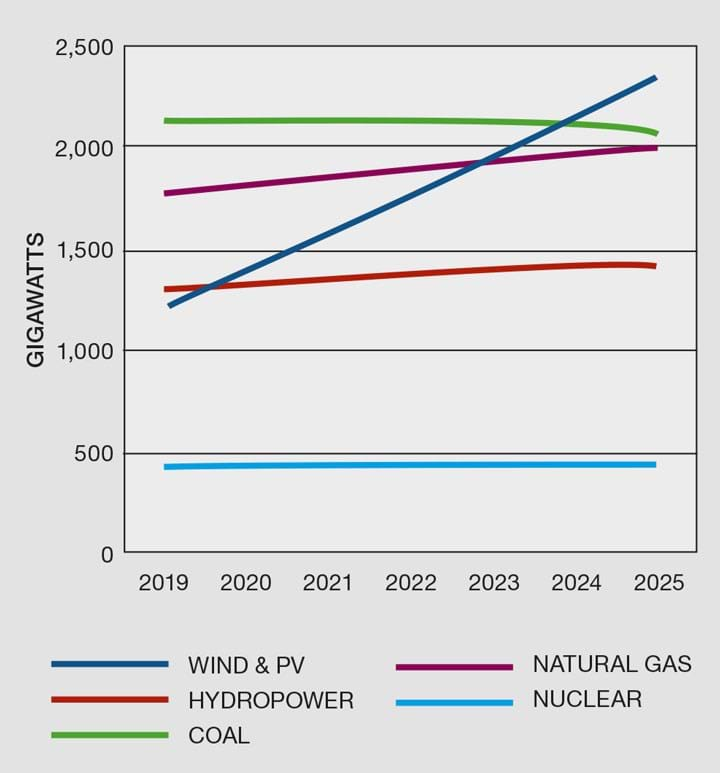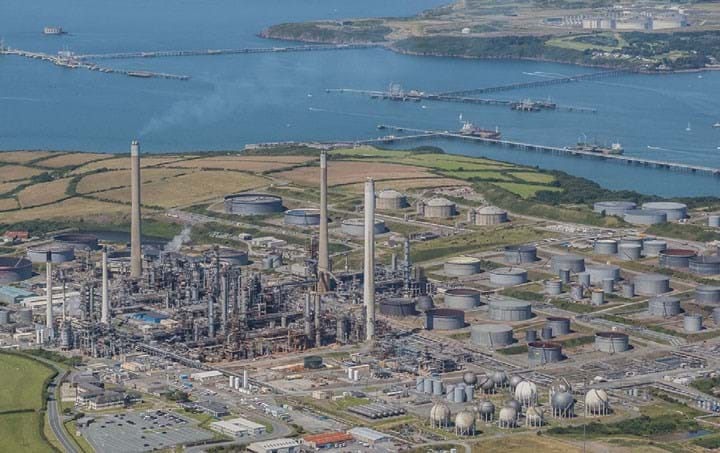Zero-Carbon Electricity
Malcolm Wilkinson and members of the Sustainability Special Interest Group discuss the technologies available for decarbonisation
ICHEME’s Sustainability Special Interest Group (SSIG) has prepared a series of thought pieces on achieving zero-carbon, a challenge and an opportunity for the engineering community in general, and chemical engineers in particular. Chemical engineers will play a crucial role in the design of pathways for the decarbonisation process in specific energy-intensive sectors, notably power, heavy industry and transport and to a lesser extent in buildings and agriculture. This is the second thought piece, the first entitled The Future of the Oil & Gas Industry1. This piece focuses on the power sector and the technologies available to decarbonise electricity. Two further pieces will cover the decarbonisation of end uses and materials efficiency.
Electricity is key to the low carbon transition. In the last 10 years electricity generation has increased by 33% – around two thirds faster than total final energy consumption – and 83% of this growth has come from non-OECD countries2. In addition, as of 2017, 840m people, living mainly in Africa, still lacked access to electricity, down from 1.2bn in 2010, and strategies will be needed to address this issue.
Whilst many national and international policies are strongly oriented towards the electrification of energy systems, electrification must proceed in parallel with decarbonisation. A strongly integrated approach across sectors and energy pathways is essential to address the adverse consequences of climate change. A holistic perspective on the entire life cycle of technological solutions is needed with consideration of potential secondary effects to avoid unintended consequences (see later) arising from today’s technology choices. The necessary systems approach requires input from all stakeholders in the supply chain and hence strong government leadership.
As far as primary fuel sources for electricity generation are concerned, coal use is already in decline and must be phased out completely, oil demand is considered to be now at peak and whilst natural gas will contribute during the transition it will also need to be decarbonised or phased out to reach the zero-carbon emissions target. The future lies with renewable energy sources.

Renewables
In 2019 renewables, solar PV and wind accounted for 10% of global electricity generation, equating to 41% of the growth in energy demand, and were growing at 14% year on year2. In addition, hydroelectricity and nuclear power accounted for a further 26% of electricity generation. The motor of change rests in emerging markets, which is where all the growth in energy demand lies. Emerging markets have higher population density, more pollution, and rising energy demand. They have less fossil fuel legacy infrastructure, rising energy dependency, and are likely to seize the opportunities of the renewables age where rapid growth and technology-driven learning curves have resulted in a fall of around 20% in costs for each doubling in capacity.
The International Energy Agency (IEA) reports that solar, wind and hydropower projects are rolling out at their fastest rate for four years. Its latest report3 predicts that by 2024 a new dawn for cheap solar power could see the world’s solar capacity grow by 600 GW, almost double the installed total electricity capacity of Japan. Overall, renewable electricity is expected to grow from 1,226 GW in 2019 by 1,200 GW in the next five years, the equivalent of the total electricity capacity of the US.
Whilst solar power is growing at an appropriate rate, wind and hydropower growth rates are slightly behind the IEA’s projections to meet its Sustainable Development Scenario (SDS), which is Paris compliant though only reaching zero-carbon in 2070. Onshore wind capacity additions began to grow again after stagnating during 2016-18 and in 2019 onshore wind electricity generation increased by an estimated 12%. A more rapid capacity increase is needed through to 2030 to get back on track with the SDS. Compared with record 32% growth in 2017, offshore wind electricity generation increased only 20% in 2018. Given its relatively small global base, offshore wind growth must accelerate even further to reach the generation levels anticipated in the SDS. The cost reductions, technology improvements through larger turbines and more recently floating structures, and the rapid deployment achieved in the UK and Europe need to be extended to other regions. Hydropower generation is estimated to have increased by over 2% in 2019 but capacity additions overall declined for the fifth consecutive year, putting this technology off track with the SDS, which requires continuous growth in newly-built capacity to maintain an average generation increase of 3% per year through to 2030.

2050 targets
Under the auspices of the United Nations (UN), world governments agreed at COP21 in Paris in 2015 to limit the global temperature increase to well below 2°C above pre-industrial levels and to pursue efforts to limit the rise to 1.5°C to avoid potentially catastrophic impacts on human existence. More recently the 1.5°C target has gained increasing focus. The Intergovernmental Panel on Climate Change (IPCC) emissions pathways to limit warming to below 2°C require net zero CO2 emissions by around 2050 from a peak in the 2020–2030 period4.
Nuclear & others
Nuclear power accounted for 10% of electricity generation in 2019, and growth of over 3% remains feasible in a number of countries, although problems related to public acceptability and challenging economics are limiting its deployment in many regions. Potential breakthroughs in nuclear generation may come from 4th-generation fission (with new fuels, improved safety, sustainability, efficiency, and cost) in the mid-term, and perhaps from fusion in the longer term, the latter being the object of multiple research projects worldwide. Research into small-scale nuclear reactors, both for fission and fusion, may also help overcome specific issues both in terms of technological development and installation costs. Whether nuclear fusion can emerge as a key technology depends not only on overcoming the current massive technological and physical barriers, but also whether it can deliver very low-cost electricity. New nuclear has to compete against the declining cost of renewable options whilst it is becoming increasingly expensive due to ever stricter safety standards.
Other low-carbon energy sources – namely concentrated solar power, biomass, geothermal and wave and tidal – account for about 2% of total electricity generation and are growing more slowly2. Negative emission technologies including bio-energy with carbon capture, utilisation, and storage (CCUS) feature in all the IPCC emission reduction scenarios but are currently at an early stage of development.
New nuclear has to compete against the declining cost of renewable options whilst it is becoming increasingly expensive due to ever stricter safety standards
The transition to renewable power generation with its distributed and intermittent nature will require systems able to shift among multiple sources of power generation and various end users to provide efficient, reliable and low-cost grid operation. Short- and long-term energy storage systems, digitalisation and artificial intelligence for demand-side management and system integration are essential developments to support this transition

Hydrogen
The use of hydrogen as an energy vector in developed economies is gaining traction as a storage medium being produced by electrolysis during periods of excess zero-carbon electricity and stored for back-up electricity generation in periods of high demand. Longer term, in countries with space and abundant sunshine – such as Australia – consideration is being given to using solar power to generate the electricity to produce hydrogen electrolytically as an export commodity replacing fossil fuel exports of coal and LNG. Ammonia (by converting hydrogen via the Haber-Bosch process), being easier to store is under consideration as an alternative. For the continuous production of hydrogen, the alternative route by steam reforming methane with carbon capture and storage is currently a cheaper option largely because of the differential between the prices of electricity and natural gas. How long this remains the case as the price of electricity from renewables continues to fall and its availability grows remains a controversial feature of current proposals.
Storage
While pumped-hydro systems still dominate electricity storage (with 96% of installed storage capacity in mid-2017), the application of battery systems for stationary storage is growing rapidly. Wider deployment and the commercialisation of new battery storage technologies has led to rapid cost reductions, notably for lithium-ion batteries (lithium production more than tripled between 2010 and 2018 though it declined in 20192), but also for high-temperature sodium-sulfur (NaS) and so-called flow batteries. There are controversial opinions on the future evolution of batteries, especially concerning costs, availability of materials and the end-of-life treatment, since recycling is currently not economically viable due to its higher cost in comparison with the use of raw material. However, battery storage in stationary applications looks set to grow from only 2 GW worldwide in 2017 to around 175 GW in 20303, rivalling pumped-hydro storage projected to reach 235 GW by then. In the meantime, as the learning curve continues, lower installed costs, longer lifetimes, increased numbers of cycles and improved performance will further drive down the cost of stored electricity services.
Going digital
Digital technologies exploiting artificial intelligence (AI) and information and communication technology (ICT) are transforming the energy landscape and creating a new generation of efficiency solutions. New digital solutions can limit production and distribution losses and accommodate growing shares of variable and distributed renewable energy while increasing grid flexibility. In recent years on the demand side, energy management systems in buildings have also become smarter, integrating external data sources, like weather conditions, traffic patterns, and more. Exploiting ICT to coordinate the features of a wide range of consumers and generators can provide a single (virtual) interface with the power grid. Using AI, these advanced systems can forecast energy demand and improve response capabilities. The increase in electric vehicles (EV) leads to new challenges for grid management, but at the same time provides additional opportunities to exploit the storage potential of the EV batteries again using AI.
The potential benefits of capitalising on these digital solutions to improve efficiency and reduce demand are significant. IEA analysis estimates that technology already available could impact the efficiency of more than 12% of 2018 global electricity consumption. By 2040 that improvement potential will nearly double, representing about one-quarter of global electricity consumption. Governments can play a key role in scaling the market for these smart devices through standards, regulations, incentives and information sharing. Digitalisation can be especially beneficial in the world’s rapidly-growing cities where dense populations, increasingly high concentrations of electric vehicles, and innovative district energy, heating, and cooling systems can work to optimise demand and consumption and aid decarbonisation.
Supporting the transition
Other flexible options to support the renewables transition are inter-country network connections and inter-sector coupling for power and heat balancing. CCUS may also play a role in enabling gas-fired electricity generation to provide backup to renewables but economics and load factors are likely to make this application country specific.
It should be noted that whilst many of the above renewable technologies are already cost competitive, electricity storage, hydrogen, CCUS and negative emissions technologies require further development and proven application at scale.
Reaching zero-carbon will require a combination of multiple technologies and the mix will vary from one country to another. The specific characteristics of different world regions present significant diversity in the drivers that are involved in decarbonising the electricity supply. Characteristics such as demand growth, current power mixes, policy priorities, electricity access, energy poverty, energy security and local regulations are different country to country. For this reason, specific strategies need to be developed by considering the local conditions, which will result in different approaches in different regions. Particularly challenging conditions are expected in Asia, where renewables development is not keeping pace with the strong rise in energy demand, as well as in Africa, where the need to increase electricity access is currently the main priority in energy planning strategies.
Systems approach
In defining strategies to achieve zero carbon electricity, a systems approach is essential to recognise the interconnectivity of actions between one course and another or between one technology and another. An action in one can be detrimental to another, while some combined efforts could amplify their cumulative effects and achieve multiple objectives. For example, the power grid itself represents a complex system that must continue to operate reliably and efficiently even as it undertakes the deepest transformation in its history. No single policy or technology can achieve decarbonisation by itself or be implemented without due consideration to its ripple effects, or the delicate state of the current, broader system.
A systems approach must recognise the legion of complementarities which impact on the overall energy system and which will affect technological choices. Complementarities such as that between natural and engineered solutions where for example energy strategies which might amplify land use degradation and deforestation must be avoided; or that between centralised and decentralised solutions since renewable energy resources are by nature different from one place to another and restrictions on land availability and use may require different power configurations. Providing solutions to such complex and open-ended problems is exactly what chemical engineers are trained for, and the transition to zero-carbon electricity presents the profession with a significant growth opportunity. Every opportunity should be taken to promote this systems approach to counter the sometimes-negative impact of solutions proposed by single issue pressure groups.
Achieving zero-carbon electricity within 30 years is the pre-requisite to address climate change, and it demands the urgent attention of governments and businesses and societal acceptance of the necessary changes
Achieving zero-carbon electricity within 30 years is the pre-requisite to address climate change, and it demands the urgent attention of governments and businesses and societal acceptance of the necessary changes. Chemical engineering and chemical engineers must play a major role in the transition.
References
1. The Chemical Engineer, May 2021, pp 54–57.
2. BP Statistical Review 2020, www.bp.com.
3. IEA Sustainable Development Scenario (www.iea.org/weo/weomodel/sds).
4. IPCC Report, Global Warming of 1.5°C, October 2018 (www.ipcc.ch/reports).
Recent Editions
Catch up on the latest news, views and jobs from The Chemical Engineer. Below are the four latest issues. View a wider selection of the archive from within the Magazine section of this site.




